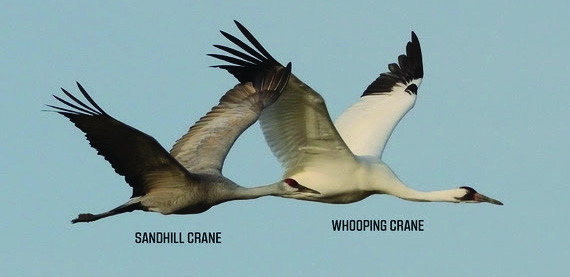Each year, sportsmen, bird watchers, and other wildlife enthusiasts can join the Wildlife Department in documenting federally endangered whooping cranes as they migrate through Oklahoma. It is important for sandhill crane hunters to be aware that whooping cranes could migrate through Oklahoma and be roosting or loafing in hunting areas at any time throughout the entire season.
The 2,500-mile journey from nesting grounds in Canada to wintering grounds in coastal Texas can take nearly two months, with the first migrating family groups of cranes reaching Oklahoma in mid- to late-October. The birds may touch down in wetlands or grain fields for a few days to rest and refuel on crustaceans, other small animals, or grain before continuing on to Texas.
The small flocks of whooping cranes that migrate through Oklahoma are part of the only remaining naturally occurring population, known as the Aransas/Wood Buffalo population.
WHAT TO LOOK FOR Whooping cranes are North America’s tallest bird, standing nearly 5 feet tall. These large, white birds have black wingtips that are seen only when in flight, and a “bustle” of feathers over the rump. Whooping cranes fly with their long neck and legs extended. Though most similar in shape and appearance to the more common sandhill crane, other large white birds like egrets and pelicans may be misidentified as whooping cranes. Egrets lack the height, rump bustle, red crown, and black wingtips of whooping cranes. American white pelicans have black wingtips but have an s-curved neck in flight and lack the height, rump bustle, and red crown.
In Oklahoma, whooping cranes are most often reported east of Guymon and west of Interstate 35.
CHECK FOR AREA CLOSURES
Should a whooping crane be sighted at a Wildlife Management Area during specific hunting seasons, the Wildlife Department may close the area until the endangered bird has continued its migration.
During a closure, the area will be prominently marked with signs and any closures will be reported at wildlifedepartment. com.



